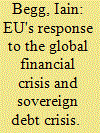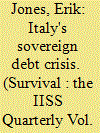|
|
|
Sort Order |
|
|
|
Items / Page
|
|
|
|
|
|
|
| Srl | Item |
| 1 |
ID:
186159


|
|
|
|
|
| Summary/Abstract |
Although the sovereign debt is primarily a long-term accounting occurrence that can emerge in the public budget, its management refers to the economic sphere as much as to the political one. Moreover, as its structure and size depend on the decisions made in both domains in a certain context, space, and time circumstances matter in debating the problem. Thus, the study of the nineteen eighties MENA economies ‘sovereign debt crises must consider also the contextual economic and political conditions and behaviours. Since these aspects represent usually subject matters for different disciplinary fields, it is difficult to take into consideration all of them without a multifaceted keynote. The concept of ‘economic policy paradigm’ can represent an analytical economic device that, alongside with the economic nature of the budget crisis, can also embed the players and the strategic interests acting in the negotiation process and in the application of the economic measures to cancel out the sovereign debt. The paper applies such analytical framework to show how, due to a change in the ‘economic policy paradigm for the development,’ the emergence of the public debt in nineteen seventies MENA economies became the ‘sovereign debt crises.
|
|
|
|
|
|
|
|
|
|
|
|
|
|
|
|
| 2 |
ID:
111025


|
|
|
|
|
| Publication |
2012.
|
| Summary/Abstract |
Since the sovereign crisis erupted in the autumn of 2009 when the true scale of the Greek fiscal deficit was revealed, the European Union (EU), and especially the euro area, has staggered from crisis to crisis. Major initiatives have, however, been taken to improve economic governance and to put in place a more resilient framework for the euro. This article assesses how the EU has responded to the crisis and offers explanations for why the reform process has been slow and indecisive. It shows that potentially enduring solutions are on the table, but that they have been hard to introduce because of differing national perspectives and disagreements about how the burdens of adjustment should be shared. The article concludes by setting out plausible options and explaining what they entail.
|
|
|
|
|
|
|
|
|
|
|
|
|
|
|
|
| 3 |
ID:
121581


|
|
|
|
|
| Publication |
2013.
|
| Summary/Abstract |
Since outbreak of the sovereign debt crisis in several member states of the Eurozone in 2010, the Euro as a success story was suddenly thrown into doubt. In Asia, more and more scholars and policy analysts, a majority of whom had not focused their study on the EU or Euro before the crisis, have criticized the monetary integration in the Eurozone, put into doubt the value of European integration as a whole, and reiterate their pessimistic theses about the future of the European economy. This article represents a rebuttal to this criticism, arguing that the common currency is truly in difficulty but not in an impasse. A return to a success story of the Euro is still probable, if European leaders and their citizens could reestablish a balancing model between the financial discipline and economic growth in the EU, to which a general and in-depth debate over the future of European integration is indispensable.
|
|
|
|
|
|
|
|
|
|
|
|
|
|
|
|
| 4 |
ID:
110300


|
|
|
|
|
| Publication |
2012.
|
| Summary/Abstract |
The bond markets turned on Italy in July 2011 as part of a wider loss of confidence in European efforts to manage the sovereign debt crisis. The centre-right government headed by Prime Minister Silvio Berlusconi attempted to head off this change in sentiment by pushing through a package of reforms to promote fiscal consolidation and to stimulate growth. Bond traders shrugged off those actions as too little and too late.
The wider European context played an important role in that assessment. The heads of state and government of the eurozone were already struggling to come up with a second Greek bailout package at the start of the summer. This resulted not only in bitter fights within countries such as Slovakia, Finland and the Netherlands, but also further scrutiny of borrowers in Ireland, Portugal and Spain. Then the European Banking Authority published the results of its second round of stress tests for systemically important European banks. These were designed to calm the markets by factoring in losses on sovereign debt instruments and generating huge volumes of data on cross-border exposure. Instead, the tests merely underscored the belief that the whole European financial system remained fragile.
|
|
|
|
|
|
|
|
|
|
|
|
|
|
|
|
| 5 |
ID:
111545


|
|
|
|
|
| Publication |
2012.
|
| Summary/Abstract |
This article considers the likely impact of the global crisis on the prospects for the European project. First, it considers the nature of the current crisis. It argues that it is comparable, in terms of its deep structural character, to the one in the 1930s. The crisis manifested itself first in the financial sector, but was caused by underlying problems of overaccumulation, which explains the succession of speculative booms and busts from the 1980s onward. The article then analyses how the financial crisis transmuted into the current sovereign debt crisis in Europe. It identifies a number of interdependent factors responsible for this: the bailouts of banks following the credit crisis; the stimulus programmes necessitated by the danger of a deep economic recession; the structural problems of the European Monetary Union leading to the accumulation of debt in the peripheral members; and finally the catalytic action of speculation in the financial markets. Finally, the article discusses responses to the debt crisis, outlining the contours of two alternatives (muddling through and Europeanisation), their implications, and some of the conditions for success. The conclusion is rather pessimistic: chances that an effective, timely and sustainable solution will be realised do not seem high.
|
|
|
|
|
|
|
|
|
|
|
|
|
|
|
|
|
|
|
|
|